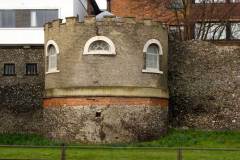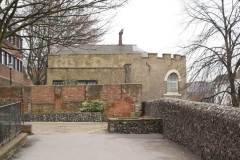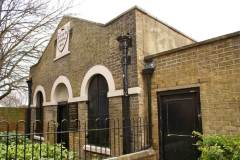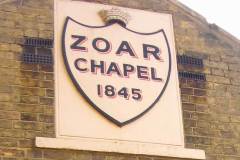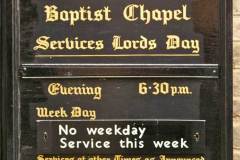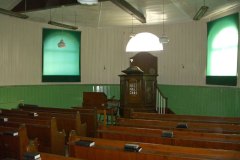3 Burgate Lane
Introduction
The former Zoar Strict & Particular Baptist Chapel lies in a bastion tower, previously housing a city water cistern, on the eastern side of Burgate Lane.
History
The city walls were rebuilt between 1378 and 1402 and later in 1620 Archbishop George Abbot paid for an extension of St Augustine’s Abbey water supply from aquifiers near St Martins church to the city centre. In 1733 a new conduit was built in the Parade but this quickly proved insufficient and in 1754 the towers of St George’s Gate were converted to house two water cisterns. In 1790 New Dover Road was constructed, increasing the traffic so much that the gate was demolished in 1801. A cistern was reprovided in an old wall bastion after it had been extended into Burgate Lane. This became the City Conduit and for a quarter of a century was used to store and pump water for the city. In 1825 a company was formed to pump water to a larger reservoir in the Castle, the redundant bastion being sold to the Strict Baptists in 1845. It is now a Grade II Listed single storey semi circular brick building with a gable end behind a small garden. The conduit head and feeder pipes can still be seen in the chapel basement.
Baptists believe in baptism by immersion. “Particular” Baptists hold to the five doctrines of John Calvin, one of which is “particular redemption”, that salvation from sin is limited to people chosen by God. The term “Strict” defines who are allowed to join in communion, here only those who adhere to the same doctrines as the Zoar chapel.
There have been general baptists in Canterbury since the mid 16th century and Particular Baptist church existed from the mid 16th to mid 17th centuries. After several short lived attempts at revival, the next Particular Baptist church was formed in 1823 and met in the Pepper Box Chapel in King’s Street. This had received its name due to its unusual polygonal shape and had been vacated by the Methodists who had moved to their new church in St Peter’s Street. This church lasted until 1838 and during the next few years a series of secessions resulted in the formation of Strict and Particular Baptists. After meeting in temporary premises they started worship at the Zoar Chapel 28th May 1845 and continue to do so today on Sunday nights.
The Hebrew “Zoar” means “small”, possibly referring to the small size of the building. It is also the name of the city in the Bible which escaped when the cities of the plain, including Sodom and Gomorrah, were destroyed, leading to Lot and his daughters probably taking refuge there.
What to see:
- The view from across Lower Bridge Street showing the medieval foundations of a flint bastion with brick reconstructions as a water cistern and chapel (Image 1).
- The views from Burgate Lane showing the extension constructed for the water cistern and the gable roof, windows and garden added for use as a chapel (Images 2-3).
- The shield above the front door, originally containing the city arms , but with only the crown remaining (Image 4).
- Exterior notice (Image 5).
- The plain interior which has a full immersion baptistery pool in the central access (Image 6).
Access: The exterior of the chapel can be viewed at any time, but the interior is not open to the public.
Sources: Hyde (2009); Lyle (2008); Boyle (1974)
http://www.britishlistedbuildings.co.uk/en-170478-zoar-chapel-canterbury
SR

